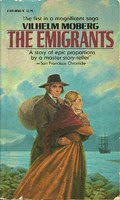
Joe Leaphorn is a coffee-drinking, doughnut-eating lieutenant of the Navajo Tribal Police. He is adjusting to retirement, the world of technology, and still feels the loss of his wife, Emma. When a tale teller rug, thought to be lost in a fire, appears intact on a rich man's wall, Leaphorn becomes interested in an old case, one of the first he worked on as a young man. His research uncovers events in Vietnam, CIA involvement, a few poison-filled cherries, and eventually comes back to two missing buckets of pinyon sap.
The Shape Shifter is a straightforward story. There's very little mystery in how all of the facts tie together and the culprit is known early, primarily because unlike in classic detective fiction, there's no pool of suspects to mask the killer's identity and keep the audience guessing.
What makes this book worth reading is the insight it provides into Navajo culture. The supernatural and mythological references build suspense. The differences between the Navajo people and the bilagaana (the white man) are thought provoking, and the story of the Long Walk, woven into the tale teller rug, led me to read more online.
Here's what I learned:
In 1864, the Navajo people were forced at gun point to walk 450 miles over the course of 18 days. They were dislocated from their home in the Arizona and New Mexico territories and resettled in Fort Sumner. Approximately 9,000 people were moved to an area sized 4o square miles. Their walk was one full of sorrow and tears. Finally, in 1868, the Navajo people were allowed to return to their homeland at which time they were given 3.5 million acres inside their four sacred mountains. This is one of the few times the Indian people were recompensed fairly.
The Shape Shifter, published in 2006, is author Tony Hillerman's last novel in the series. He died in 2008 after publishing 18 novels about the American Southwest.
Genre: Crime Fiction
Sub-category: Regional Mystery
Sub-category: Police Procedural
This is my interpretation of a "regional" mystery. While there are other authors whose books are categorized this way, there's very little discussion online about the traits that encompass them all.
Traits:
- Story takes place in a specific region or city and the site is more than just a setting in the novel. It is instructional about the society and its traditions in addition to providing ambiance.
- The people and culture become an important part of the story, in some ways overshadowing the mystery itself.
The Shape Shifter can also be categorized as a Police Procedural, although a true example would probably include technical elements about how the crime is solved.
Traits:
- Police officers are central characters, men or women with ordinary abilities, whose "real" lives play a part of the story.
- The story is told from the police point of view.
- The criminal is often known or thinly disguised.
I will expand on this list after reading a more complex Police Procedural. If you have input, please post a comment or email.
 The free online dictionary defines "wake" as follows: "The visible track of turbulence left by something moving through water."
The free online dictionary defines "wake" as follows: "The visible track of turbulence left by something moving through water."
 Everyone should write a book like this one.
Everyone should write a book like this one. 

 Joe Leaphorn is a coffee-drinking, doughnut-eating lieutenant of the Navajo Tribal Police. He is adjusting to retirement, the world of technology, and still feels the loss of his wife, Emma. When a tale teller rug, thought to be lost in a fire, appears intact on a rich man's wall, Leaphorn becomes interested in an old case, one of the first he worked on as a young man. His research uncovers events in Vietnam, CIA involvement, a few poison-filled cherries, and eventually comes back to two missing buckets of pinyon sap.
Joe Leaphorn is a coffee-drinking, doughnut-eating lieutenant of the Navajo Tribal Police. He is adjusting to retirement, the world of technology, and still feels the loss of his wife, Emma. When a tale teller rug, thought to be lost in a fire, appears intact on a rich man's wall, Leaphorn becomes interested in an old case, one of the first he worked on as a young man. His research uncovers events in Vietnam, CIA involvement, a few poison-filled cherries, and eventually comes back to two missing buckets of pinyon sap.





